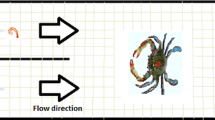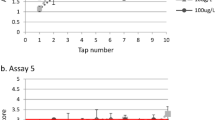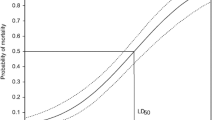Abstract
Using behavioral criteria developed in previous studies, the threshold concentration at which the blue crab,Callinectes sapidus, detected the petroleum hydrocarbon naphthalene was found to be 10−7 mg/l. Oriented locomotor activity and defensive displaying began at 2 mg/l of naphthalene. No feeding behavior was observed up to and including the maximum naphthalene concentration of 5 mg/l. Below 2 mg/l the blue crab apparently had no active behavioral response to naphthalene exposure other than detection.
Similar content being viewed by others
Literature Cited
Anderson, J. W., J. M. Neff, B. A. Cox, H. E. Tatum, andG. M. Hightower. 1974a. Characteristics of dispersions and water-soluble extracts of crude and refined oils and their toxicity to estuarine crustaceans and fish.Mar. Biol. 27:75–88.
—————. 1974b. The effects of oil on estuarine animals: Toxicity, uptake and depuration, respiration, p. 285–310.In F. J. Vernberg and W. B. Vernberg (eds.). Pollution and Physiology of Marine Organisms. Academic Press, New York.
Atema, J. 1976. Sublethal effects of petroleum fractions on the behavior of the lobster,Homarus americanus, and the mud snail,Nassarius obsoletus. p. 302–312.In M. Wiley (ed.). Estuarine Processes, Vol. I. Uses, Stresses, and Adaptation to the Estuary. Academic Press, New York.
Burrows, M., andA. O. D. Willows. 1969. Neuronal coordination of rhythmic maxilliped beating in brachyuran and anomuran crustacea.Comp. Biochem. Physiol. 31:121–135.
DiMichell, L., andM. H. Taylor. 1978. Histopathological and physiological responses ofFundulus heteroclitus to naphthalene exposure.J. Fish. Res. Board Can. 35:1060–1066.
DiMichell, L., andM. H. Taylor. 1978. Histopathological and physiological responses ofFundulus heteroclitus to naphthalene exposure.J. Fish. Res. Board Can. 35:1060–1066.
Draper, N. R., andH. Smith. 1966. Applied Regresssion Analysis. John Wiley and Sons, New York. 407 p.
Engstrom-Heg, R. 1971. A lightweight Marriotte bottle for field, laboratory and hatchery use.Prog. Fish-Cult. 33:227–231.
Jachowski, R. L. 1974. Agonistic behavior of the blue crab,Callinectes sapidus Rathbun.Behaviour 50:232–253.
Kittredge, J. S., F. T. Takahashi, and F. O. Sarinana. 1974. Bioassays indicative of some sublethal effects of oil pollution, p. 891–897.In Proc. Tenth Ann. Conf. Mar. Tech. Soc. Washington, D.C.
Laverack, M. S. 1975. Properties of chemoreceptors in maine crustacea, p. 141–146.In D. A. Denton and J. P. Coghlan (eds.). Olfaction and Taste V. Academic Press. New York.
Lee, W. Y., andJ. A. C. Nicol. 1978. The effect of naphthalene on survival and activity of the amphipodParhyale.Bull. Environ. Contam. Toxicol. 20:233–240.
Mackie, A. M. 1973. The chemical basis of food detection in the lobsterHomarus gammarus.Mar. Biol. 21:103–108.
McLeese, D. W. 1974. Olfactory responses of lobsters (Homarus americanus) to solutions from prey species and to seawater extracts and chemical fractions of fish muscle and effects of antennule ablation.Mar. Behav. Physiol. 2:237–249.
Neff, J. M., andJ. W. Anderson. 1975. An ultraviolet spectrophotometric method for the detection of naphthalene and aklylnapthalenes in the tissue of oil-contaminated marine animals.Bull. Environ. Contam. Toxicol. 14:122–128.
Olla, B. L., A. L. Studholme, and W. H. Pearson. (In Press) Behavior as a measure of adaptation. USSR-USA Workshop on Physiology and Biochemistry of Aquatic Animals. Belle W. Baruch Institute for Marine Biology and Coastal Research. Columbia, South Carolina.
Pearson, W. H., andB. L. Olla. 1997. Chemoreception in the blue crab,Callinectes sapidus.Biol. Bull. 153:346–354.
—and—. 1979. Detection of naphthalene by the blue crab,Callinectes sapidus.Estuaries 2:63–64.
Percy, J. A. 1976. Responses of arctic marine crustacenas to crude oil and oil-tainted food.Environ. Pollut. 10:155–162.
Rossi, S. S., andJ. M. Neff. 1978. Toxicity of polynuclear aromatic hydrocarbons to the polychaeteNeanthes arenaceodentata.Mar. Poll. Bull. 9:220–223.
Slobodkin, L. B., andA. Rapoport. 1974. An optimal strategy of evolution.Q. Rev. Biol. 49: 181–200.
Takahashi, F. T., and J. S. Kiteredge. 1973. Sublethal effects of the water soluble component of oil. Chemical communication in the marine environment, p. 259–264.In D. G. Ahearn and S. O. Meyers (eds.). The Microbial Degradation of Oil Pollutants. Louisiana State Univ. Press Publ. No. LSU-SG-73-01.
Author information
Authors and Affiliations
Rights and permissions
About this article
Cite this article
Pearson, W.H., Olla, B.L. Threshold for detection of naphthalene and other behavioral responses by the blue crab,Callinectes sapidus . Estuaries 3, 224–229 (1980). https://doi.org/10.2307/1352073
Issue Date:
DOI: https://doi.org/10.2307/1352073




